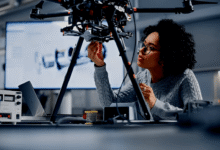The Role of Artificial Intelligence in Modern Surveillance Cameras
Discover how artificial intelligence is transforming modern surveillance cameras by enhancing threat detection, improving accuracy, and enabling smarter, real-time security solutions.

In recent years, integrating artificial intelligence (AI) into surveillance cameras has revolutionized how security systems operate. Traditional surveillance methods often relied on human monitoring and manual recording, but with the advent of AI technology, these systems now offer unprecedented levels of efficiency, precision, and automation.
AI-powered surveillance cameras can analyze vast amounts of data in real-time, enabling faster threat detection, enhanced accuracy in identifying individuals or objects, and the ability to learn and adapt to new security patterns. This shift has not only improved security measures but has also paved the way for smarter, more responsive surveillance solutions across various industries. Companies like SSC are at the forefront of innovative surveillance solutions enhanced by AI technology.
How AI is Revolutionizing Surveillance
AI introduces several advanced capabilities to surveillance cameras, making them more than mere passive recording devices. Here are some key improvements:
Smart Motion Detection
AI-powered cameras can differentiate between various types of motion. For example, they can distinguish between a person, an animal, or a vehicle. This reduces false alarms and ensures security personnel are alerted only when real threats are detected. Some systems can even track objects and individuals over time, providing valuable insights for forensic analysis.
Facial Recognition
Modern AI systems can identify individuals in real-time by analyzing facial features. This feature is invaluable for access control, identifying suspects, or monitoring high-security areas. Advanced facial recognition algorithms can even identify individuals wearing masks or partially obscured by objects, further enhancing their utility in various scenarios.
Behavior Analysis
AI enables cameras to recognize suspicious behavior patterns, such as loitering, sudden movements, or entering restricted zones. By analyzing such patterns, the system can alert security teams before an incident occurs. This proactive approach allows organizations to mitigate risks and respond more effectively to potential threats.
License Plate Recognition (LPR)
Advanced AI algorithms can accurately capture and analyze license plates from moving vehicles, which is essential for managing parking lots or securing entry points. The data collected can be integrated with databases for automated entry systems or law enforcement applications, making it easier to track stolen vehicles or unauthorized access.
Real-Time Alerts
AI systems process data instantaneously, providing real-time notifications via mobile apps or security dashboards. This rapid response capability is critical in preventing potential incidents. Security teams can receive alerts with detailed information, such as the type of threat detected and its location, allowing for swift action.
Edge Computing Capabilities
Many modern AI surveillance cameras feature edge computing, where data processing occurs directly on the device rather than relying on cloud servers. This reduces latency, improves performance, and enhances data privacy by minimizing the need to transfer sensitive information over networks.
Benefits of AI in Surveillance
Improved Efficiency
AI reduces the need for constant human monitoring by automating analysis and reporting. Security personnel can focus on actionable alerts instead of reviewing hours of footage.
Cost-Effectiveness
Automated systems cut down labor costs associated with manual monitoring and reduce operational expenses. Additionally, AI systems can optimize resource allocation, ensuring that security measures are deployed where they are most needed.
Enhanced Accuracy
AI minimizes human errors and ensures reliable detection, reducing false positives and negatives. Advanced algorithms continuously learn and adapt, improving their accuracy over time.
Scalability
AI-based systems can easily adapt to growing security needs, accommodating more cameras and data without compromising performance. This makes them ideal for both small businesses and large enterprises.
Comprehensive Data Insights
AI-powered surveillance systems can generate detailed analytics reports, providing insights into patterns and trends. For example, businesses can analyze customer foot traffic, while city planners can study traffic flow and pedestrian movement.
AI and Data Privacy
While AI has immense potential, it also raises concerns about data privacy. Responsible companies like SSC prioritize user privacy by implementing robust encryption protocols, anonymizing sensitive data, and adhering to strict compliance standards. These measures ensure that AI-enhanced surveillance remains secure and ethical.
Furthermore, organizations must be transparent about their data collection practices and ensure compliance with regional and international privacy laws, such as GDPR. This builds trust with users and promotes responsible AI adoption.
Challenges in AI-Driven Surveillance
Despite its advantages, AI in surveillance faces several challenges:
- Ethical Concerns: The use of facial recognition and behavior analysis raises ethical questions about surveillance overreach and potential misuse.
- Bias in AI Algorithms: Improperly trained algorithms may exhibit bias, leading to inaccuracies in detection and identification.
- High Initial Costs: Implementing AI-powered systems can be expensive, particularly for small businesses.
- Cybersecurity Risks: AI systems are vulnerable to hacking and other cyber threats, emphasizing the need for robust security measures.
Applications in Various Industries
Retail
AI-powered surveillance is used to monitor customer behavior, reduce theft, and optimize store layouts. For example, cameras can analyze shopping patterns to improve product placement and enhance the customer experience.
Transportation
In transportation, AI helps manage traffic, ensure passenger safety, and secure transit hubs. Intelligent cameras can monitor crowded areas, detect unattended luggage, and assist in traffic enforcement.
Healthcare
Hospitals use AI-enhanced cameras to protect sensitive areas, manage patient flow, and ensure the safety of medical staff. These systems can also monitor hygiene compliance and detect unauthorized access to restricted zones.
Residential
AI offers smart home security solutions that integrate seamlessly with other IoT devices. Homeowners can receive real-time alerts, monitor their property remotely, and automate responses to potential threats.
Manufacturing and Industrial Sites
AI surveillance cameras are invaluable in industrial environments, monitoring machinery, ensuring worker safety, and detecting unauthorized access to critical areas.
Future Trends in AI Surveillance
The future of AI in surveillance is promising, with several exciting trends emerging:
- Integration with IoT: AI systems will increasingly integrate with IoT devices, creating comprehensive security ecosystems.
- Predictive Analytics: Advanced algorithms will predict potential threats based on historical data, enabling preemptive action.
- Enhanced Cybersecurity: AI will play a key role in securing surveillance systems against cyber threats.
- Affordable AI Solutions: As technology advances, AI-powered systems will become more accessible to small and medium-sized businesses.
Conclusion
Artificial intelligence is redefining the security landscape by enhancing the capabilities of surveillance cameras. From facial recognition to real-time alerts, AI-powered systems offer unparalleled security and efficiency. Companies like SSC are leading the charge, ensuring that businesses and individuals can benefit from cutting-edge surveillance solutions. By addressing challenges and embracing advancements, AI-driven technology not only improves security but also paves the way for smarter, safer environments.
Whether in retail, transportation, healthcare, or residential settings, AI surveillance systems are shaping a future where security is proactive, intelligent, and reliable. The continued development and responsible implementation of AI promise a safer world for all.











